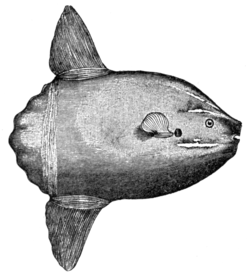1911 Encyclopædia Britannica/Sunfish
SUNFISH, a name chiefly and properly applied to a marine fish (Orthagoriscus) of the order Plectognathi, which by its large size, grotesque appearance and numerous peculiarities of organization has attracted the attention equally of fishermen as of naturalists. Only two species are known, the rough or short sunfish (O. mola), which is found in all seas of the temperate and tropical zones; and the smaller and scarcer smooth or oblong sunfish (O. truncatus), of which only a small number of specimens have been obtained from the Atlantic and Indian oceans.
Sunlishes have the appearance of tailless fish. This is due to the extreme shortening of the caudal region which is supported by only a few short vertebrae; the caudal nn is absent, what appears to be a tail being formed by the confluence of dorsal and ventral fms: pelvic fins are also wanting. The anterior parts of the dorsal and ventral fins are high and broad, similar to each other in size and triangular in form. The head is completely merged in the trunk, the boundary between them being indicated only by a very small and narrow gill-opening and a comparatively small pectoral fin. This fin can be of but little use in locomotion, and the horizontal and vertical movements of the fish, as well as the maintenance of its body in a vertical position, are evidently executed by the powerful dorsal and anal fins. The small mouth, situated in front of the head, is armed with an undivided dental plate above and below, similar to but weaker than the teeth of the globe-fish (Diodon).
Sunfishes are truly pelagic, propagating their species in the

Sunfish (Orthagoriscus mola).
open sea, and only occasionally approach the coast. During the stormy season they live probably at some depth, but in calm, bright weather they rise and rest or play on the surface with their dorsal fin high above the water. This habit has given rise to the popular name "sunfish," a term also sometimes applied to the basking-shark. In some years the rough sunfish is by no means scarce on the south coast of England and on the Irish coasts, where it appears principally in the summer months. The usual size is from 3 to 4 ft. in length, but this species attains to 7 ft. and more. One of the largest specimens (shown in the figure) was caught near Portland (Dorsetshire) in 1846, and is now in the British Museum; its length is 7 ft. 6 in. The sunfish has no economic value, and is rarely, if ever, eaten.
Whilst the rough sunfish has a granulated, rough, shagreen-like skin, the second species (O. truncatus) has the surface of the body smooth and polished, with its small dermal scutes arranged in a tessellated fashion. It is oblong in shape, the body being much longer than it is deep. The sides are finely ornamented with transverse silvery, black-edged stripes running downwards to the lower part of the abdomen. It has not been found to exceed 2 ft. in length. Only a few specimens have been captured on the coasts of Europe, at the Cape of Good Hope and off Mauritius.
